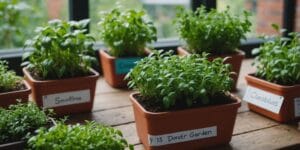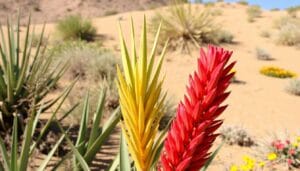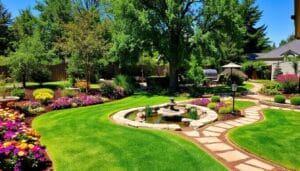Starting a backyard farm is an exciting journey. It lets you grow your own food, making it fresher and healthier. Plus, it can save you money on groceries. With the right help, anyone can begin their backyard farming adventure.
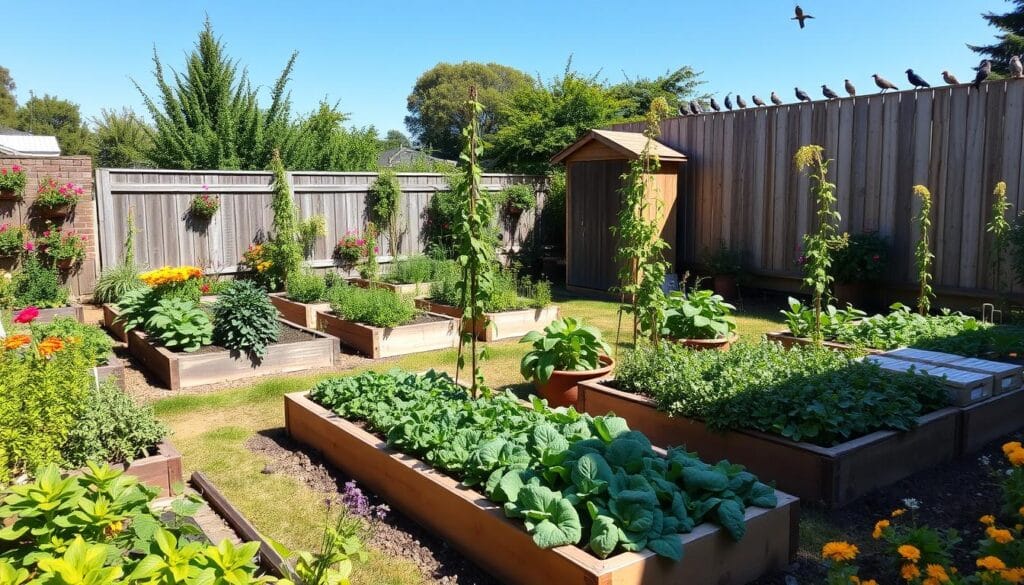
Backyard farming and home gardening are closely linked. They let you grow your own fruits, veggies, and herbs. This way, you can reduce your need for store-bought food. Learning the basics of backyard farming helps you create a successful home garden. It brings you a sense of pride and accomplishment.
Understanding Backyard Farming Basics
Backyard farming lets you grow your own food at home. It’s a way to make fresh fruits, veggies, and herbs. This method helps you know what’s in your food and cuts down on industrial farming. It also brings joy and health benefits from gardening.
To start, you need to know about organic farming and garden planning. A good backyard garden gives you fresh food and a feeling of pride. Think about your climate, soil, and space when planning. You’ll also need to know how to deal with pests and diseases.
- Choosing the right crops for your climate
- Preparing and maintaining the soil
- Managing pests and diseases using organic methods
- Implementing efficient irrigation systems
Learning these basics and using organic farming in your garden planning will help. You can make a backyard garden that gives you healthy food for your family.
| Backyard Farming Benefits | Description |
|---|---|
| Fresh Produce | Access to fresh, healthy fruits, vegetables, and herbs |
| Therapeutic Benefits | Enjoy the therapeutic benefits of gardening and outdoor activity |
| Control Over Food | Control what goes into your food, reducing reliance on industrial agriculture |
Assessing Your Space and Resources
To achieve self-sufficiency through backyard farming, you need to check your backyard space and gardening resources. Look at your yard’s size, sunlight, and soil type. These details will guide what you can grow and how to use your space well.
Understanding your backyard space limits and possibilities is key. Note where the sun shines most and where it’s shady. This helps choose the right plants for each spot. Also, think about the gardening resources you have, like water, tools, and seeds.
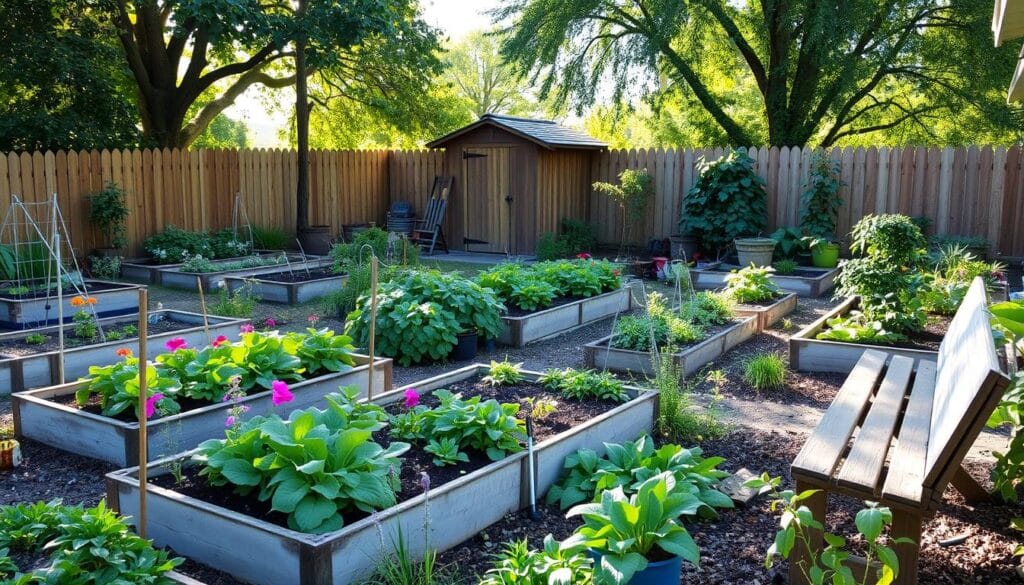
- Measure your yard to know its size and layout
- Test your soil to find out its type and pH level
- Research the best plants for your climate and soil
- Make a list of the gardening resources you have
By carefully looking at your backyard space and gardening resources, you can build a successful backyard farm. This will help you reach self-sufficiency and enjoy growing your own food.
Essential Tools and Equipment for Success
To succeed in backyard farming, you need the right tools and equipment. Basic gardening tools like a shovel, rake, and hoe are key. They help prepare and keep the soil in good shape. Having the right tools boosts your farm’s productivity and efficiency.
Irrigation systems are also crucial. Systems like drip irrigation or soaker hoses ensure plants get the right water. This is vital for their growth. Proper watering prevents overwatering, which can harm the soil and plants.
Soil testing is another important part of backyard farming. It helps you know the soil’s pH and nutrient levels. This info guides your decisions on fertilizers and soil amendments. Testing the soil lets you fix any issues and create a healthy growing space.
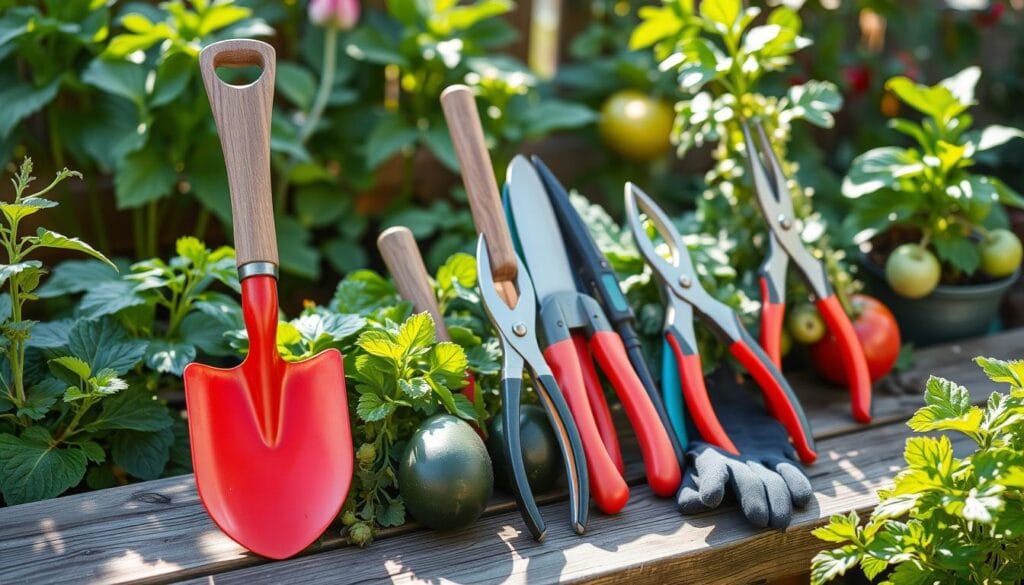
- Storage solutions, like a garden shed or cold frame, to keep tools organized and safe
- Compost bins, to make nutrient-rich soil from food scraps and yard waste
- Gardening gloves, to protect your hands from thorns and sharp objects
| Tool/Equipment | Purpose |
|---|---|
| Gardening tools | Prepare and maintain soil |
| Irrigation systems | Provide plants with the right amount of water |
| Soil testing equipment | Determine pH and nutrient levels of the soil |
Planning Your Backyard Farm Layout
Creating a productive and sustainable garden starts with a good plan. A well-designed garden design helps you use your space wisely. It ensures each plant gets the right sunlight, water, and nutrients. Think about how big your plants will grow and what they need to thrive.
Crop rotation is key in your backyard farm layout. It keeps the soil healthy, fights pests and diseases, and feeds your plants well. A diverse garden is more resilient and productive.
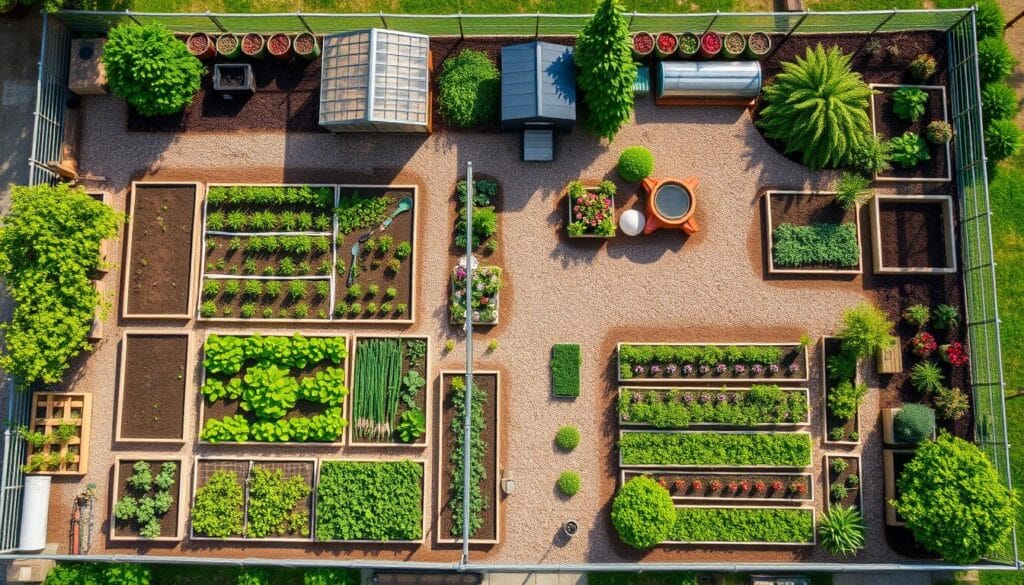
To get the most from your space, try raised beds, containers, or vertical gardening. These methods save space, improve soil, and cut down on waste. A smart backyard farm layout and garden design lead to a thriving garden. It will give you fresh produce for years.
- Assess your space and resources to determine the best layout for your backyard farm
- Consider using raised beds, containers, or vertical gardening to maximize your yields
- Incorporate crop rotation into your backyard farm layout to maintain soil fertility and reduce pests and diseases
Follow these tips for a bountiful harvest and a sustainable garden. It will bring you joy and fresh produce for years.
Selecting the Right Crops for Your Climate
Understanding your local climate is key for a successful backyard farm. Knowing your growing zones helps you choose the right plants. This ensures a healthy and productive harvest. Also, seasonal planting is crucial for making the most of your growing season.
A good seasonal planting guide helps you know what to plant and when. It considers temperature, rainfall, and daylight hours. This approach creates a diverse and resilient garden. It also helps plants work together, improving growth and reducing pests.
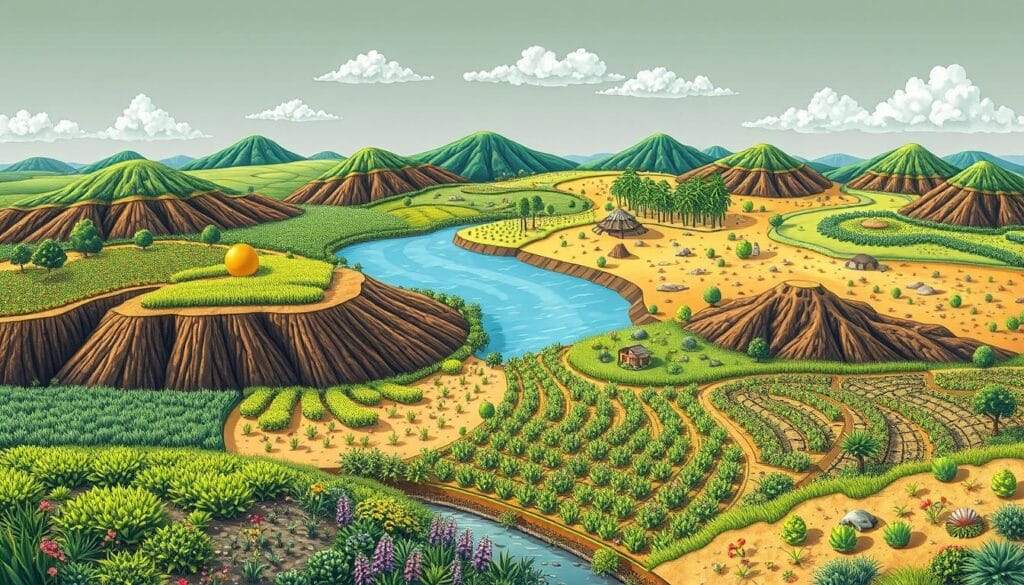
Popular crops for backyard farming include tomatoes, cucumbers, and carrots. These can grow well in many growing zones with the right care. By following a seasonal planting guide and using companion planting strategies, you can have a thriving garden. It will provide fresh produce for you and your family.
| Crop | Growing Zone | Planting Time |
|---|---|---|
| Tomatoes | 3-9 | Spring |
| Cucumbers | 4-10 | Summer |
| Carrots | 3-10 | Spring/Fall |
By understanding your local climate and choosing the right crops, you can have a thriving backyard farm. Always follow a seasonal planting guide and use companion planting strategies. This will ensure a healthy and productive harvest.
Soil Preparation and Maintenance
Soil preparation is key in backyard farming. It helps plants grow well. You test the soil’s pH and nutrient levels. Then, you add compost or manure and till or aerate it.
Composting makes a natural fertilizer. It turns waste into a nutrient-rich soil amendment.
Keeping the soil healthy is also important. You can do this by mulching, cover cropping, and rotating crops. These practices help your soil stay fertile and productive.
Some important strategies for soil care include:
- Testing soil pH and nutrient levels to know what to do next
- Adding compost or manure to make the soil better
- Mulching and cover cropping to stop soil erosion and help microbes
- Crop rotation to fight diseases and keep the soil fertile
By using these methods, you can make your backyard farm thrive. It will grow healthy, abundant crops.
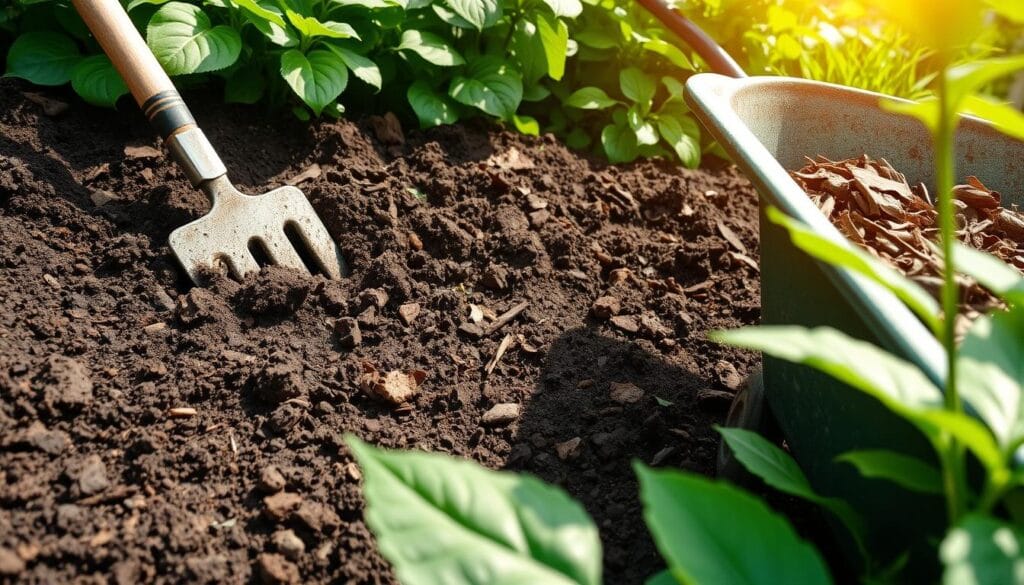
| Soil Preparation Technique | Benefits |
|---|---|
| Composting | Creates natural fertilizer, reduces waste, and improves soil structure |
| Mulching | Reduces soil erosion, promotes healthy microbial activity, and retains soil moisture |
| Crop Rotation | Breaks disease and pest cycles, maintains soil fertility, and promotes biodiversity |
Natural Pest Control Methods
When you take care of your backyard farm, pests can harm your crops. Instead of using chemical pesticides, try natural pest control methods. This keeps your garden healthy and protects the environment. It also helps keep beneficial insects and animals safe.
Common pests include aphids, slugs, and snails. To fight these, use organic solutions like neem oil, diatomaceous earth, and picking them off by hand. Neem oil, for instance, is great for fighting many pests, from aphids to whiteflies.
Organic Solutions
- Neem oil: a natural insecticide that controls aphids, whiteflies, and other pests
- Diatomaceous earth: a powder that dehydrates and kills slugs, snails, and insects
- Hand-picking: a simple and effective method for removing pests from plants
Preventive steps can also help avoid pests. Introduce beneficial insects like ladybugs and lacewings to control pests naturally. Use physical barriers, like fine-mesh screens, to keep pests away from your plants. By mixing these methods with good garden care and preventive measures, you can have a thriving backyard farm.
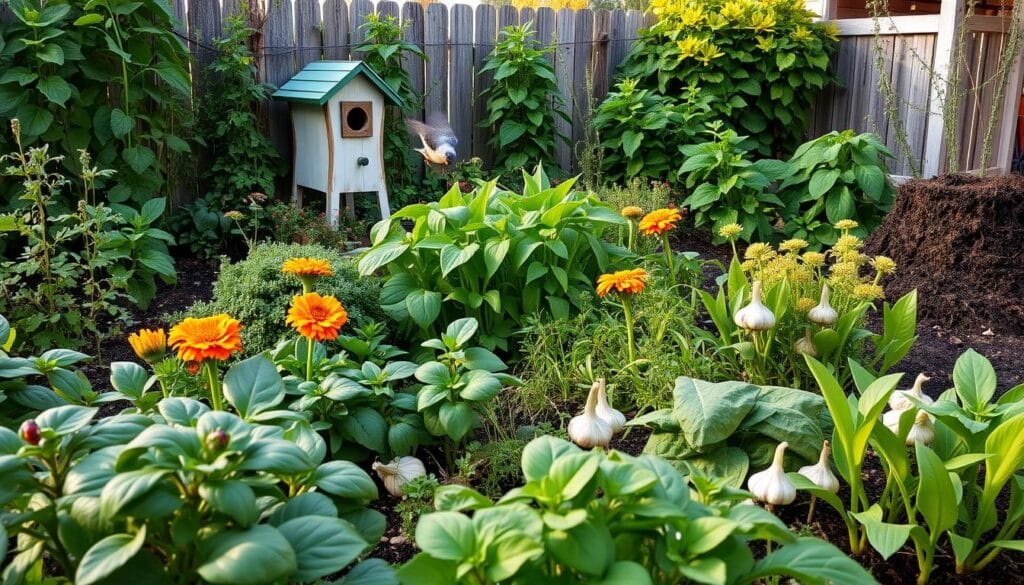
Preventive Measures
Being proactive with natural pest control means less need for pesticides. This keeps your garden balanced and healthy. It’s good for your plants and helps the environment. Using natural pest control and organic solutions leads to a bountiful harvest.
Harvesting and Storage Tips
Timing is key when harvesting your crops. Picking them at the right time ensures they taste best and are most nutritious. For instance, leafy greens like lettuce and kale are perfect in the morning, when they’re at their freshest.
After you’ve picked your crops, it’s time to think about storage. The right storage keeps your harvest fresh for longer. Here are some tips for storing your crops:
- Use airtight containers to keep fruits and vegetables fresh
- Freeze or dehydrate crops to preserve them for later use
- Consider using techniques like canning, pickling, or fermenting to preserve your food and create delicious and healthy meals
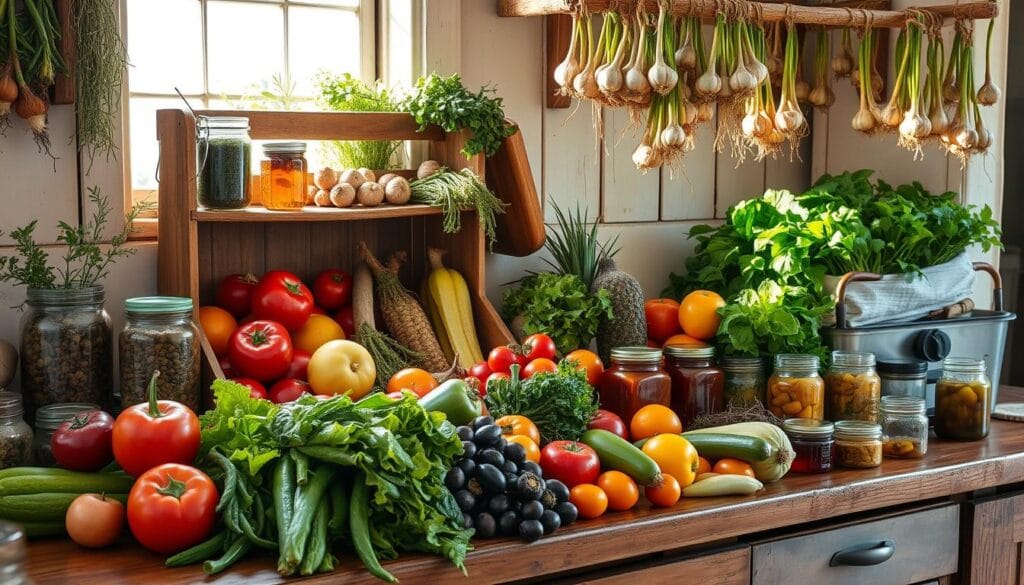
Food preservation is also crucial. It lets you enjoy your harvest all year and cuts down on waste. Methods like freezing, canning, and dehydrating are popular. By using these tips, you can enjoy your hard work and make the most of your backyard farm.
| Method | Description |
|---|---|
| Freezing | Freezing is a great way to preserve fruits and vegetables. Simply blanch the produce, then freeze it in airtight containers or freezer bags. |
| Canning | Canning is a popular method of food preservation that involves packing produce in airtight containers and heating them to kill off bacteria and other microorganisms. |
| Dehydrating | Dehydrating involves removing the water content from produce to prevent spoilage. This can be done using a food dehydrator or by simply drying the produce in the sun. |
Conclusion: Your Journey to Self-Sustainability
As you reach the end of your backyard farming journey, celebrate the progress you’ve made. Growing your own food nourishes your body and connects you to the land. You’ve also learned to appreciate the natural rhythms of the seasons.
Remember, backyard farming is a journey that never ends. Keep trying new things, like different crops and gardening techniques. This way, you’ll find more joy and satisfaction in your work.
Your backyard farm is a special place that shows who you are and where you live. Face challenges head-on and celebrate your wins. With hard work and curiosity, you can make your backyard a green oasis.
FAQ
What is backyard farming?
Backyard farming, or home gardening, is growing your own food in your backyard. It’s a way to make fresh fruits, vegetables, and herbs in a sustainable way.
What are the benefits of growing your own food?
Growing your own food lets you control what you eat. It reduces your need for industrial farms. Plus, it’s good for your mental health.
What essential skills do I need to start backyard farming?
You need to know your climate and how to prepare soil. Also, learning to spot and deal with pests is key.
How do I assess my space and resources for backyard farming?
First, check your backyard’s size and sunlight. Look at your soil and what resources you have, like water and tools.
What essential tools and equipment do I need for backyard farming?
You’ll need basic gardening tools and irrigation systems. Also, storage solutions and soil testing equipment are important.
How do I plan the layout of my backyard farm?
Plan your garden’s layout carefully. Think about plant sizes and growing needs. Use space wisely with raised beds or containers.
How do I select the right crops for my climate?
Choose crops that fit your climate. Know your growing zone and plant seasonally. Use companion planting for better growth.
How do I prepare and maintain my soil?
Soil care is crucial. Test its pH and nutrients. Add organic matter and use mulch, cover crops, and compost.
What natural pest control methods can I use in my backyard farm?
Use organic pest control like neem oil and beneficial insects. Keep your garden clean to avoid pests.
How do I properly harvest and store my backyard farm produce?
Harvest at the right time and store in airtight containers or freeze. You can also can, pickle, or ferment your food.



